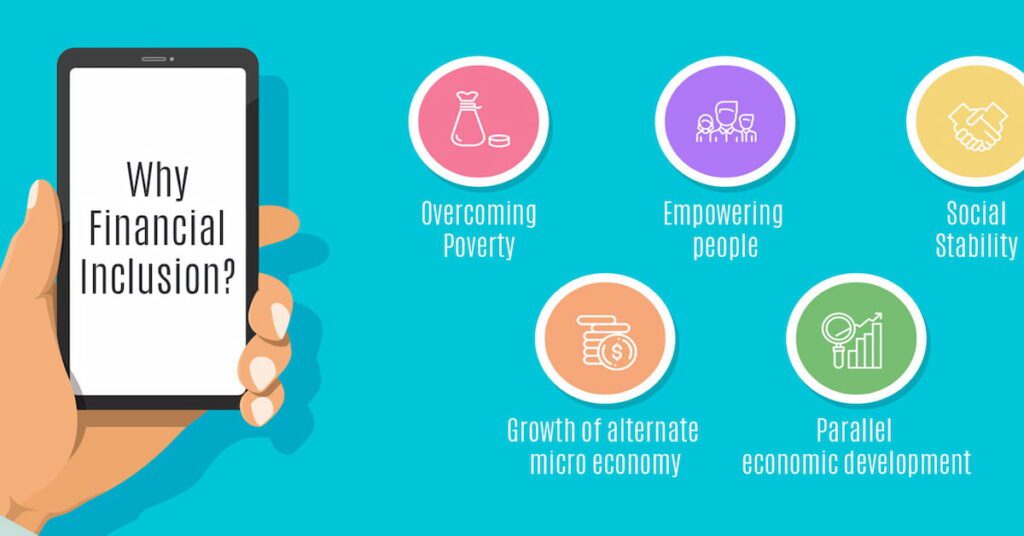The entire world is a giant village now. Isn’t it? Everyone can connect through the internet. The liberalization of the financial systems has led to the birth of a worldwide financial ecosystem(Financial Inclusion). Nations can trade with each other. The transactions can be smoothly done across countries.
One might say that the financial system has become far more developed with the advancement of technology.
Yet, a part of the world population is not included in this financial ecosystem.


Who are they? and What does financial inclusion mean?
The majority of the rural population especially women are not financially included.
It simply means that they do not have an account with the bank. This is also known as the unbanked population. According to the RBI report, India has a staggering unbanked population of 190 million adults. It states that 190 million adults do not even have a savings account. This makes India the second country on the unbanked list, only falling behind China.
Financial inclusion refers to the provision of financial services to those who are traditionally excluded or underserved by the mainstream financial sector. This primarily includes low-income individuals, rural populations, and those without access to traditional banking services or financial models of the modern world. The goal of financial inclusion is to provide access to basic financial services such as savings, credit, insurance, and payments to people who need it, in order to improve their economic well-being and empower them to participate fully in the economy.
Financial inclusion in India refers to the effort to provide access to basic financial services, such as savings accounts, credit, insurance, and payments, to those who are excluded or underserved by the traditional financial sector, particularly low-income individuals, rural populations, and the unbanked.
Now, let’s see why financial inclusion is an absolute necessity?
Even in the earlier days, people needed loans and advances. Isn’t it? Where do you think they borrowed loans from? – Back in those days, people (mostly farmers) borrowed loans from zamindars. These zamindars often took advantage of poor peasants and used to charge hefty interest on loans.
If farmers could not pay back, they were held as bonded laborers which would trickle down from generation to generation. Yes, this was a real practice in India, no matter how harsh it sounds. To combat such inhuman practices, the Central Bank formed NABARD for development in the agriculture sector. Farmers can easily avail of loans at reasonable interest rates.
The Central bank also wants people to develop the habit of savings. This is the reason why banks always encourage the general public to at least open a savings account. They will be able to earn interest out of their savings which would have otherwise been used for expenditure.
Having an account will give access to various financial services like loans, debit card facilities, credit cards, internet banking, and so on. Not having an account shuts down the possibility of these services.
People will not be able to use what already exists for them. Financial inclusion is to bring people into the financial ecosystem. Sure, economies are seeing growth. But the world needs inclusive and holistic growth.
World bank and financial inclusion
The World Bank works actively to garner financial inclusion. Thus, aiding people to start their financial journey. Financial Inclusion Global Initiative (FIGI) is an initiative by the World Bank Group along with its associates to bring financial inclusion. The World Bank firmly believes that financial inclusion can alleviate poverty and bring inclusive growth.
The international organization works closely with governments for this purpose. The Zero Balance Account initiative by Narendra Modi- Hon’ble Prime Minister of India was undertaken for financial inclusion. The Digital Govt. ID i.e., Aadhar Card was used for faster processing and opening of saving accounts.
Conclusion
Financial education, financial inclusion, and financial stability are three key elements of financial literacy that ultimately lead to the progress of a nation. Financial inclusion works from the supply side by providing adequate and timely access to various financial services. Financial education, on the other hand, works from the demand side by creating and promoting awareness among the masses regarding the importance and benefits of financial services offered by the banking and the financial sector. These two strategies in combination and perfect sync are essential for the overall financial stability that is crucial for any nation.
